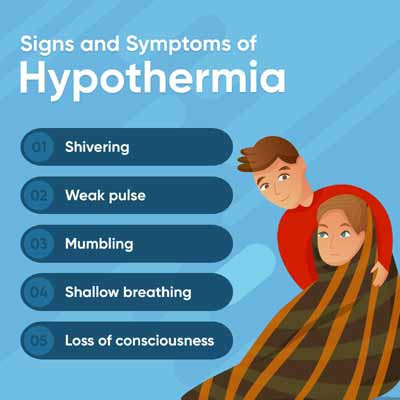Hypothermia a risk when temperatures drop

Cold winter temperatures begin to appear as early as November. While some people retreat into their homes to escape the chill, plenty of others embrace winter because of the opportunities for recreational activities such as snowboarding, skiing, snowtubing, and much more. Many do not mind the brisk temperatures, preferring the cold when walking the neighborhood or hiking nearby trails.
However, just as activities enjoyed in hot climates put individuals at risk for heat-related health emergencies, when the mercury drops, hypothermia can compromise outdoor enthusiasts’ health. The Mayo Clinic says hypothermia is a medical emergency that occurs when the body loses heat faster than it can produce heat. While body temperature normally hovers around 98.6 F, hypothermia sets in when body temperature falls below 95 F.
Hypothermia occurs as a result of prolonged exposure to cold temperatures. It also can happen after capsizing into cold water or even sweating and then getting chills when the temperature drops.
WebMD says that, during exposure to cold temperatures, around 90 percent of heat loss escapes through the skin, and the rest is exhaled from the lungs. Heat loss speeds up when the skin is exposed to moisture or wind. In response, the body will shiver to produce heat through muscle activity. Furthermore, the body also will temporarily narrow blood vessels, called vasoconstriction. Activity of the liver and heart normally produces most of the body’s heat. But as core temperature drops through hypothermia, these organs will engage in a protective shutdown to preserve heat and protect the brain.
Anyone spending time outdoors in the cold weather should be aware of the most common symptoms of hypothermia so that prompt action can be taken. Such symptoms include:
• excessive shivering
• slowed speech
• clumsiness
• slowed breathing
• stumbling
• confusion
• weak pulse
• excessive fatigue
Infants and older adults have a higher risk of developing hypothermia due to a decreased ability to regulate body temperature.
Hypothermia is an emergency situation, so it is necessary to call 911 immediately if you or a companion suspects its presence. Treatment goals include increasing body temperature to a normal range. While waiting for trained medical professionals, these steps can be taken.
• Remove wet clothing.
• Cover the person with warm blankets, including the face but not the mouth. If no blankets are available, use body heat to warm one another.
• Try to administer warm soup or beverages if the person is conscious.
• Apply warm compresses to the chest, neck or groin.
• Do not move the person around or attempt to massage their body to help restore heat, as it could put the individual at risk for cardiac arrest.
Hypothermia is a serious condition that requires prompt attention when temperatures begin to drop.

